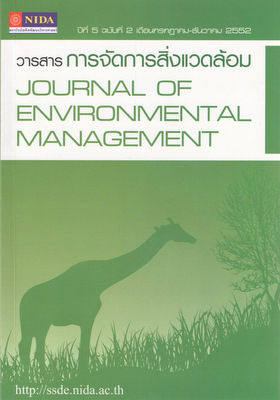การใช้น้ำสกัดชีวภาพหนอนตายหยากเป็นปุ๋ยสำหรับการผลิตถั่วเหลือง/The Use of Bio-extracted Water from Stemona Herb for Fertilizer in Soybean Production
บทคัดย่อ
งานวิจัยนี้มีวัตถุประสงค์เพื่อศึกษาการใช้น้ำสกัดชีวภาพหนอนตายหยากเป็น ปุ๋ยสำหรับการ ผลิตถั่วเหลือง โดยได้ทำการศึกษาและเปรียบเทียบการเจริญเติบโต ผลผลิต และองค์ประกอบผลผลิต ของถั่วเหลือง รวมถึงศึกษาลักษณะสมบัติทางเคมี ปริมาณธาตุอาหาร และการสะสมโลหะหนักในดิน ได้แก่ ตะกั่ว แคดเมียม และปรอท วางแผนการทดลองแบบสุ่มสมบูรณ์ หน่วยการทดลองใช้น้ำสกัดชีวภาพหนอนตายหยากต่อน้ำธรรมดาในอัตราส่วน 1.00:1,000, 2.00:1,000, 3.00:1,000 และ 4.00:1,000 น้ำสกัดชีวภาพอีเอ็มต่อน้ำธรรมดาในอัตราส่วน 1.00:1,000 ปุ๋ยเคมีสูตร 12.0-24.0- 12.0 ปริมาณ 10.0 กรัม พบว่า น้ำสกัดชีวภาพหนอนตายหยากต่อน้ำธรรมดาในอัตราส่วน 2.00:1,000 ส่งผลให้ถั่วเหลืองมีแนวโน้มการเจริญเติบโตในส่วนของน้ำหนักแห้งของฝัก น้ำหนักแห้งรวม ผลผลิต จำนวนฝักต่อต้น น้ำหนักเมล็ด และปริมาณโปรตีนในเมล็ดมากกว่าหน่วยการทดลองอื่นๆ รวมถึงมี ระยะการเจริญเติบโตทางการแพร่ขยายพันธุ์ที่ยาวกว่าปุ๋ยเคมี ส่วนความสูง จำนวนข้อ และพื้นที่ใบ นั้น ปุ๋ยเคมีมีค่าสูงกว่าเล็กน้อย
The objective of this study was to find out the use of bio-extracted water from Stemona herb as a fertilizer in soybean production. The effectiveness was determined in terms of plant growth, yield, and yield component, including nutrients in soil and heavy metals contaminated in soil, i.e., lead, cadmium and mercury. The experimental design was a completely randomized design which divided into 7 treatments with 4 replications for each treatment. The bio-extracted water from Stemona herb and water were mixed at ratios of 1.00:1,000, 2.00:1,000, 3.00:1,000 and 4.00:1,000, the bio–extracted water from effective microorganisms, chemical fertilizer formula 12.0-24.0-12.0 at the rate of 10 grams/ pots, and the control group. The results showed that the bio-extracted water from Stemona herb mixed with water at the ratio of 2.00:1,000 gave the highest growth rate of soybean in terms of pod dry matter, total dry matter, yield, number of pods per plant, seed weight, and protein in seeds. In addition, the reproductive growth period of the plant at the ratio of 2.00:1,000 is longer than that of chemical treatment. However, the plant height, node number, and leaf area were higher when chemical fertilizer was applied.



